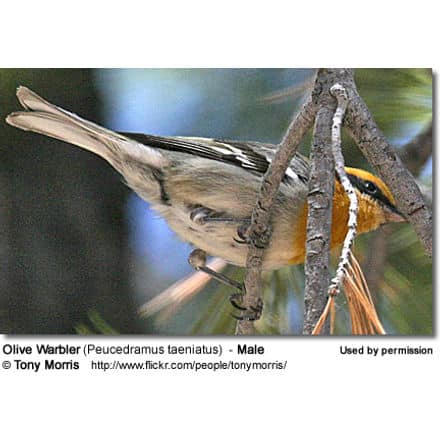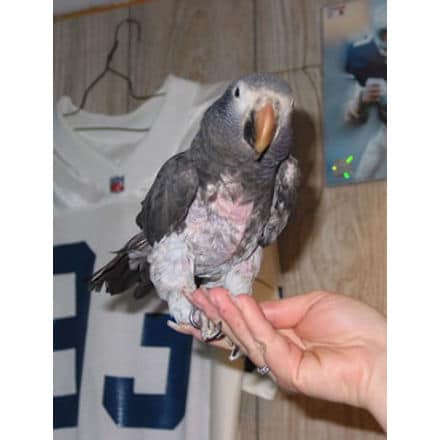Olive Warblers, Peucedramus taeniatus
Olive Warblers, Peucedramus taeniatus
Overview … Alternate (Global) Names
Distribution / Habitat … Subspecies, Ranges and ID
Description … Calls / Vocalizations
Breeding / Nesting … Diet / Feeding
The Olive Warblers (Peucedramus taeniatus) are generally considered to be “warblers,” but these medium-sized, long-winged songbirds are placed into their own bird family: Peucedramidae. They are native to North and Central America.
Distribution / Habitat
They occur from southwest USA from Yavapai County, Arizona and the southwestern tip of New Mexico, as far east as the mountains of far west Texas. In Mexico, their range stretches from central to southern Mexico, with isolated populations in Tamaulipas and Coahuila in Northeastern Mexico, and Sonora and Chihuahua in Northwestern Mexico.
Further south, they are found in southwest Guatemala and from northern El Salvador and central Honduras to northern Nicaragua.
They inhabit high elevation pine (mostly ponderosa pine), alder, fir, Douglas-firs, and mixed oak-pine woodlands. They have been observed to use pines almost exclusively for foraging and nesting. In coastal areas, they may use stands of palms.
In the northern parts of their range, they are typically found at elevations of 8,500 feet (2,600 meters) and above. During the winter, some may move down to lower elevations into oak forests. Further south, they may down as low as to 3,280 feet (1,000 meters).
Over large parts of their range, these birds are resident (non-migratory). However, northerly populations may move disperse after the breeding season or move down to lower elevations. Many of those found in the USA, leave in November and return in late February in time for the breeding season.
Subspecies and Ranges:
- Olive Warbler (Peucedramus taeniatus taeniatus – Du Bus, 1847) – Nominate Form
- Range: South-central Mexico in the Mexican state of Guerrero south to Guatemala.
- [Peucedramus taeniatus georgei ] – Proposed race; mostly considered part of the nominate form
- Range: Southern Mexico in Southern Oaxaca
- [Peucedramus taeniatus aurantiacus] – Proposed race; mostly considered part of the nominate form
- Range: South central Guatemala in the town of Chilascó in Baja Verapaz, Guatemala.
- Olive Warbler (arizonae) (Peucedramus taeniatus arizonae – Miller and Griscom, 1925)
- Range: Southern Arizona and southwestern New Mexico in southwestern USA, and northwestern Mexico, where they are found in northeastern Sonora south to southwestern Chihuahua.
- Olive Warbler (jaliscensis) (Peucedramus taeniatus jaliscensis – Miller and Griscom, 1925)
- Range: Southern Chihuahua in northern Mexico; central Coahuila, southern Nuevo León and western Tamaulipas in Northeastern Mexico south to San Luis Potosí and Jalisco in central western Mexico and Colima in western Mexico.
- Olive Warbler (giraudi) (Peucedramus taeniatus giraudi – Zimmer, JT, 1948)
- Range: Central Mexico from Jalisco and Michoacán east to west central Veracruz.
- Olive Warbler (micrus) (Peucedramus taeniatus micrus – Miller and Griscom, 1925)
- Range: Honduras, west to extreme northern El Salvador and south to northern Nicaragua.
Description
Size
The Olive Warblers measures 4.7 – 5.5 inches (12 – 14 cm) in length – including the tail. They weigh 0.34 – 0.42 oz (9.5 – 12 g). The northern populations tend to be larger than those found in the south.
Plumage Details / Adults
The Olive Warblers back and most of the wings are grey, with some olive-green markings on the wing and two white wing bars. The lower chest down to the undertail coverts (feathers) is whitish.
The males can be identified by the orange-brown head, throat and chest , and the black facial mask extending through the eyes.
The head of females and juveniles is orange instead. The crown is greenish and there is a yellow-orange wash to the throat and chest. They have dark cheek patches.
Geographical differences also occur, with southern birds being more brightly colored.
Other Physical Details
The bill is thin and pointed. The legs are black.
Similar Species
There generally aren’t any birds that could be confused with the male Olive Warbler. Females and juveniles can be identified by their unstreaked underparts and dark cheek patches.
Diet / Feeding
They mostly feed on insects gleaned from twigs and from the bases of needle clusters found in the upper third of pines and other trees. The often join mixed feeding flocks with other warblers, titmice, nuthatches and others.
Breeding / Nesting
The Olive Warblers nest is an open cup constructed out of moss, lichen, pine bud scales and pine needles; and lined with white plant fibers taken from the underside of silver oak leaves, as well as rootlets.
A clutch usually consists of 2 – 5 bluish-white eggs with brown and olive blotches at the large end. One brood is produced in a season.
The eggs are incubated by the female for about 12 – 13 days. The male may help, but this has not been confirmed.
Both parents are believed to raise the young.
Calls / Vocalizations / Sounds
The songs are described as clear whistles, hirrJI hirrJI hirrJI, plida plida plida chir chir. The song is most commonly heard in midmorning throughout the year, but during the breeding season males is vocal during the mornings and late afternoons.
Alternate (Global) Names
Chinese: ????? … Czech: hájní?ek pruhok?ídlý, Lesnácek zelenožlutý … Dutch: Oranjekopzanger … Danish: Sangerfinke … Finnish: Vuorikerttuli … French: Fauvette à tête fauve, Fauvine des pins, Paruline à tête fauve, Paruline des pins … German: Trugwaldsänger, Trug-Waldsänger … Italian: Parula olivacea, Peucedramo … Japanese: oriabuamerikamushikui, ori-buamerikamushikui … Norwegian: Kløfthaleparula … Polish: zlotoglówka, z?otog?ówka … Russian: ????????? ???????????? ????? … Slovak: ihliciar hôrny, ihli?iar hôrny Spanish: Chipe Ocotero, Chipe Oliváceo, Chipe olivo, Ocotero, Ocotero Enmascarado, Reinita Olivácea … Swedish: Ockrahuvad skogssångare
Species Research by Sibylle Johnson
Please Note: The articles or images on this page are the sole property of the authors or photographers. Please contact them directly with respect to any copyright or licensing questions. Thank you.








